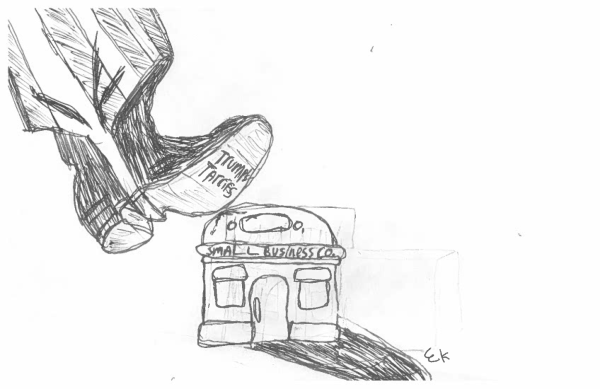Nutrition Rules are a Half-Step to Changing Student Habits
Lawmakers will not be successful until they consider the dynamics of high school and the psychological components of societal change.
The Smart Snacks in Schools program, the latest federal government crusade against childhood obesity, is a well-intentioned policy that may positively impact American children. However, like many educational policies, its specific stipulations may undermine the healthy culture it tries to create.
The policy, effective this school year at BHS, demands food sold during school hours meet strict nutritional standards. This affects school lunch offerings and prevents student organizations from selling their typical pastry fare from midnight to 30 minutes after the school day’s end.
It is clear that governments must do something to stop a national public health crisis. According to the Center for Disease Control, the national adolescent obesity rate has increased from five percent of the population in 1980 to 21% in 2012. The 2013 Case Western Reserve University Youth Risk Behavior survey revealed that 12.6% of local teens are obese. These are alarming statistics when one considers the higher heart disease, cancer and mortality rates of obese individuals.
There is very little the government can do to control the kinds of food individuals eat, as these choices are often too personal and individualized for feasible bureaucratic intervention. The educational system is one of the few arenas where the government can control nutrition and affect a large portion of the population. Furthermore, if children eat healthier, obesity is cut at its root; bad habits can be reversed, and unhealthy kids can turn into fit adults. Thus, the schools present an ideal way to tackle this first-world scourge.
The power in these policies lies in their psychological implications. It is unclear whether eating one healthy meal a day is enough to trim students’ waistlines. At schools like BHS, which do not typically provide students with breakfast, children are still free to consume at least two unhealthy meals daily. They can also still eat non-nutritious snacks after school or any food they bring from home. When schools are subjected to governmental statutes, there is an expectation that in most circumstances, they enforce it without complaint. When schools encourage healthy food, they are creating a social norm that makes health a community priority and labels sugary, high-fat options as unacceptable. The message is that the school authorities support a healthy lifestyle. Kids are more likely to respect a value that community leaders stand behind. Thus, these policies have the potential to stop unhealthy habits before they start.
It is logical that school-funded food, like items sold at lunchtime and in vending machines, should meet nutritional standards. However, the same logic does not apply to student organizations. Clubs are comprised of students, who have no obligation to be compliant enforcers of the law. If they have to sell food that they think will generate them fewer sales or they cannot sell certain profit-making delicacies, than they will feel restricted and have negative attitudes toward the policy. Thus, when students see new healthy snacks in the lunch line, they will not slowly change their habits, but be deliberately reactive against the laws. The bake sales the law restricts are not daily occurrences and likely have little effect on students’ body mass indexes. Thus, legislators, by impacting clubs with this policy, alienate the very people they are trying to win over.
It is not enough for the government to will obesity away with feel-good ad campaigns or friendly cafeteria posters. They must take action to protect the health of Americans, and Smart Snacks shows progress toward this end. Yet lawmakers will not be successful until they consider the dynamics of high school and the psychological components of societal change.












